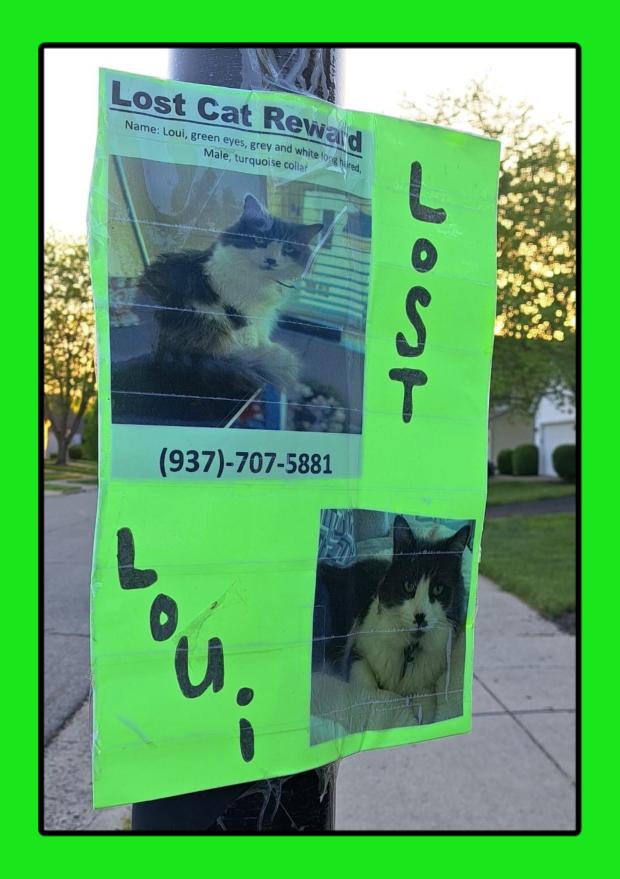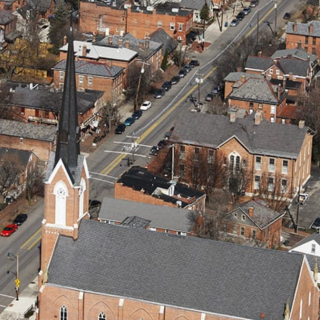Advertisement
On the farthest western edge of Columbus, in a patch of forest which days are probably numbered, several coyotes howl in the night. These same coyotes, believed to be three brothers, were recently witnessed dashing across 70 West near 270.
The coyote’s patch of woods is connected to a subdivision where the houses look alike. Of late there’s more “Missing Cat” signs taped to lamp posts (sushi for coyotes, believe some).
Also being squeezed out are the houseless, but their tents remain. “Brett,” who bought a 100-year-old farm house near here, said he’s called 311 nine times over the past year to have an abandoned tent (pictured above) removed from Clover Park, but no City employee has ever shown.
Some Far West Side residents told the Free Press they believe the houseless and the coyotes were forced to flee. From bulldozers and hundreds of $400,000 houses arising from plowed soybean fields, prairie, and sporadic forest. Other Far West Siders disagree, saying coyotes have been living near their subdivisions for decades.
One development now emerging from the dirt and rocks, with over 1,000 single-residence homes and apartments, is ironically named “Sugar Farms,” by Pulte Homes and Harmony Development Group.
“They [the coyotes] have nowhere else to go. It’s because of all the development around here,” says a Far West Side Columbus homeowner who also did not want to offer their name for publication. Several years ago, this homeowner’s three-bedroom house with a basement, backyard and garage was valued at $150,000. Today it’s over $300,000, and their monthly bill is $1,100. Cheaper than any Sugar Farms’ apartment – it’s lowest at $1,500-a-month for two-bedrooms.
Sugar Farms is Urban Sprawl in all its lengthening glory. And just a short walk from here is another large development under construction, Renner Park. Both developments turning Central Ohio into more of a monster-sized overeating and overheating concrete pancake. On the Far East it was once Pickerington, now its Intel.
Hundreds of cars will also soon be a big part of Sugar Farms. Yet only three roads can access it, with all three being one lane in and one lane out. What’s more, while Sugar Farms is in Columbus, parents can send their kids to Hilliard City Schools due to it being a “Win-Win” suburb. Yet the closest elementary school, Hilliard Horizon, is already overcapacity.
“Do not contact City Council members – at all.”
The Far West Side Area Commission is relatively new, formed in 2019. The commission’s chair is Sharon Rastatter, who spent a year creating a required taskforce and gathering 500 signatures to have City Council approve the commission.
Her commission voted unanimously against the proposed rezoning which led to Sugar Farms. But just a reminder, area commissions are strictly an “advisory body,” they have no real power. After any area commission rezoning vote, it goes to the Columbus Development Commission for a vote and then to Columbus City Council.
“There were two [Columbus Development] commission meetings for this. In the first one I think we felt we were being listened to. We mentioned this wasn’t a straight up rezoning for twenty houses. This was massive,” said Rastatter.
During the second meeting, experts were called in by the Columbus Development Commission. “Those experts were people working for the developers,” said Rastatter. “It was obvious then we weren’t going to prevail.”
After this they dealt with City Council, which in essence, told them to get lost, and then unanimously approved Sugar Farms.
“Initially when this was first proposed, our liaison with the Department of Neighborhoods at the time, Melissa Green, had advised us ‘Do not contact City Council members – at all.’ But some residents did contact Council members because they voted for them,” said Rastatter.
Melissa Green has left that position and is currently running, albeit uncontested, for City Council in the 6th District (Hilltop). Green called Rastatter back not long after residents began calling City Council to complain about Sugar Farms.
“She (Green) got very angry and upset. She even called me and told me ‘Under no uncertain terms’ was I to tell people to call City Councilmembers,” said Rastatter.
As Urban Sprawl gobbles up western Franklin County, these developments come closer and closer to the Big Darby Creek, a National Wild and Scenic Rivers. In 2004 the Big Darby Accord was established to protect this watershed. But the Accord’s advisory panel approved Sugar Farms 4 to 3. This was the “trigger” to move Sugar Farms ahead, says Kelley Arnold, the Far West Side Area Commission’s zoning chair.
“The Big Darby Accord, while it had a say, that’s say was not strong enough,” says Arnold. “Partially because when you look at the make-up of their panel, these are people who are very much concerned about the environment, know the specifics of this environment, but don’t necessarily have a developer background and how to work through the challenges of government.”
The Big Darby Accord advisory panel recommended Sugar Farms be 1 unit per acre, but the developers and the City approved it for 3 units per acre.
“What cities have done [after interpreting state and local development related law to their liking] is allow for ‘density bonuses’ if they’ve done certain restoration or green space requirements,” says Arnold. “The whole process can easily be exploited. Because it involves many different panels and City departments, and they’ve been doing this for decades. They know how to work this process. Whereas residents, including people like ourselves on this commission, have that challenge of being outside this process.”
Both Rastatter and Arnold, and many other local residents, say the biggest issue they have with Sugar Farms is “density.”
“We’re just residents and volunteers,” says Rastatter. “We don’t have attorneys on our staff. We don’t have all the resources they have. We’re just doing what we can with what we have.




